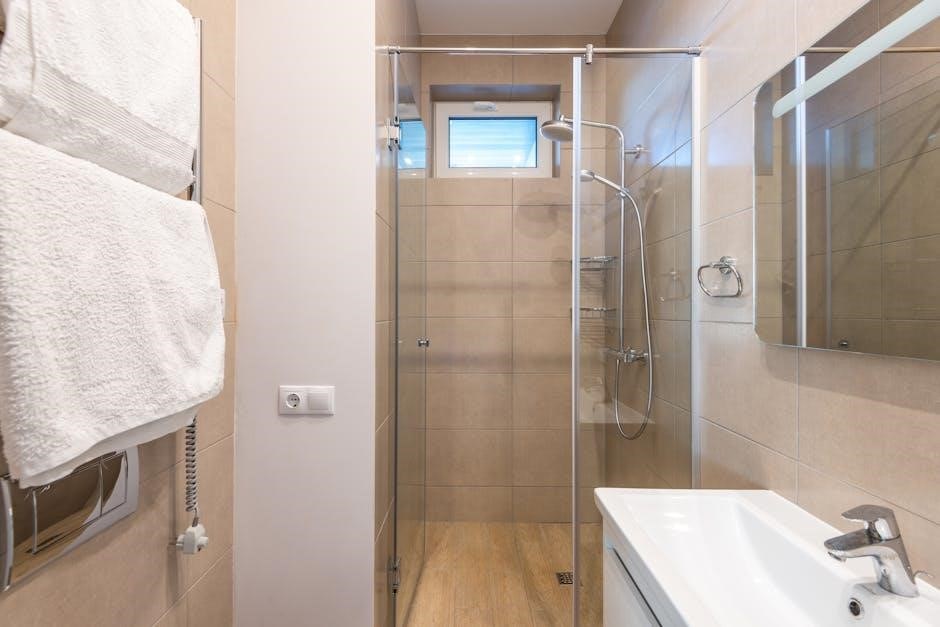The PleurX Catheter System is a medical device designed for draining excess fluid from the chest or abdomen at home. It provides a safe and effective solution for managing conditions like pleural effusion and ascites‚ offering patients greater autonomy and comfort during recovery. Proper use and care are essential to ensure safety and prevent complications.
1.1 Overview of the PleurX Catheter System
The PleurX Catheter System is a medical device designed for draining excess fluid from the chest or abdomen at home. It includes a tunneled catheter‚ vacuum bottle‚ and drainage kit. Patients can drain fluid themselves after proper training. The system is intended to manage conditions like pleural effusion and ascites‚ helping alleviate symptoms such as shortness of breath. It offers a safe and reliable solution for home use‚ reducing the need for prolonged hospital stays. Proper use and adherence to instructions are crucial for optimal outcomes.
1.2 Importance of Proper Drainage Instructions
Proper drainage instructions are crucial for the safe and effective use of the PleurX Catheter System. Adhering to guidelines helps prevent complications such as infections‚ blockages‚ or damage to the catheter. Correct techniques ensure fluid is drained safely‚ reducing the risk of re-expansion pain or nerve irritation. Following the provided instructions minimizes potential issues and promotes successful fluid management. Patients should thoroughly understand the process before starting and seek medical advice if unsure. Proper drainage is key to maintaining comfort and preventing adverse outcomes.
Understanding the PleurX Catheter
The PleurX Catheter is a medical device designed for draining excess fluid from the chest or abdomen. It features a tunneled catheter and a vacuum-sealed collection system‚ enabling patients to manage drainage safely at home with minimal discomfort. Proper understanding of its components and functionality is essential for effective use and care.
2.1 What is a PleurX Catheter?
The PleurX Catheter is a tunneled catheter system used for draining excess fluid from the pleural space or abdomen. It consists of a flexible catheter‚ a fenestrated drain‚ and a vacuum bottle for fluid collection. Designed for home use‚ the system allows patients to manage conditions like pleural effusion or ascites comfortably. The catheter is inserted by a healthcare professional and remains in place for ongoing drainage‚ improving lung expansion and reducing discomfort. It is a minimally invasive solution that enhances patient mobility and quality of life.
2.2 How the PleurX Catheter Works
The PleurX Catheter operates by creating a vacuum seal that gently drains excess fluid from the pleural space or abdomen. Once attached to the vacuum bottle‚ the catheter uses negative pressure to remove fluid‚ allowing the lung to re-expand. The system is designed for patient-controlled drainage‚ enabling individuals to manage their condition at home. The process is straightforward‚ with the vacuum bottle collecting the fluid‚ which can then be measured and disposed of safely. This mechanism ensures effective and comfortable fluid removal‚ improving respiratory function and overall well-being.

Indications for PleurX Catheter Use
The PleurX Catheter is indicated for managing pleural effusion and ascites‚ conditions where excess fluid accumulates in the chest or abdomen‚ requiring drainage to relieve symptoms.
3.1 Pleural Effusion
Pleural effusion is the accumulation of excess fluid in the pleural space surrounding the lungs‚ often causing breathlessness and discomfort. The PleurX Catheter is a minimally invasive solution to drain this fluid‚ allowing patients to manage the condition at home. It enables effective relief from symptoms and improves quality of life by reducing fluid buildup. The catheter’s design facilitates easy drainage‚ empowering patients to take an active role in their care and maintain independence.
3.2 Ascites
Ascites‚ the accumulation of excess fluid in the abdominal cavity‚ often results from liver disease‚ heart failure‚ or cancer. The PleurX Catheter is an effective solution for managing ascites‚ allowing patients to drain fluid at home. This minimally invasive system reduces abdominal swelling and discomfort‚ improving mobility and quality of life. Regular drainage with the PleurX Catheter helps prevent complications and avoids the need for frequent hospital visits. Proper training and adherence to drainage instructions are crucial for safe and effective use.

Contraindications for PleurX Catheter Use
The PleurX Catheter is contraindicated in patients with certain conditions‚ such as severe infections‚ allergic reactions to catheter materials‚ or situations where fluid removal could cause medical complications.
4.1 Conditions Where PleurX Catheter is Not Advised
The PleurX Catheter is not recommended for patients with severe infections‚ trapped lung‚ or diaphragmatic rupture. It is also contraindicated in cases of allergic reactions to catheter materials. Additionally‚ individuals with unexpandable lungs or those requiring urgent thoracic surgery should avoid using this device; Proper medical evaluation is essential to determine suitability for PleurX Catheter use‚ ensuring patient safety and avoiding potential complications.

Preparing for PleurX Catheter Drainage
Ensure all supplies are ready‚ including the drainage kit‚ vacuum bottle‚ and cleaning materials. Wash hands thoroughly‚ and clean the catheter site with an alcohol pad before starting the process.
5.1 Gathering Necessary Supplies
Before starting the drainage process‚ ensure all necessary supplies are within reach. This includes the PleurX drainage kit‚ a new alcohol pad for cleaning‚ and the vacuum bottle. Additional supplies like gauze‚ sterile gloves‚ and a measuring container may also be needed. Always verify the integrity of the drainage kit by checking for any damage or expiration dates. Having all items ready helps streamline the process and minimizes interruptions during drainage. Consult the manufacturer’s instructions for a complete list of required materials.
5.2 Ensuring Proper Hygiene
Proper hygiene is crucial to prevent infections during PleurX catheter drainage. Begin by washing your hands thoroughly with soap and water. Clean the catheter site with a new alcohol pad‚ ensuring the area is dry before proceeding. Always use sterile gloves if available. Maintain a clean environment around the catheter to reduce contamination risks. Regularly inspect the site for signs of infection‚ such as redness or swelling. Follow the manufacturer’s guidelines for hygiene practices to ensure safety and effectiveness during the drainage process.

Step-by-Step Drainage Instructions
Prepare the drainage kit‚ clean the catheter site‚ and attach the vacuum bottle. Drain fluid slowly‚ monitor flow‚ and re-establish the vacuum seal afterward to complete the process safely.
6.1 Preparing the Drainage Kit
Begin by opening and organizing all components of the drainage kit on a clean surface. Ensure the vacuum bottle‚ drainage tubing‚ and catheter are intact and free from damage. Wash your hands thoroughly with soap and water‚ then dry them completely. Put on gloves if provided in the kit. Carefully remove any protective covers from the tubing and bottle‚ ensuring sterility is maintained. Finally‚ position the kit near you for easy access during the drainage process.
6.2 Attaching the Vacuum Bottle
Securely attach the vacuum bottle to the drainage tubing‚ ensuring a clean and tight connection. Connect the tubing to the catheter‚ avoiding any twists or kinks. Position the vacuum bottle below the level of your chest or abdomen to prevent fluid backflow. Gently squeeze the bulb on the vacuum bottle to create suction‚ then release it to allow fluid to drain naturally. Always follow the manufacturer’s instructions for proper attachment and suction adjustment. Refer to the provided guide for detailed steps and safety precautions.
6.3 Draining the Fluid
Once the vacuum bottle is attached‚ fluid will begin to drain from the catheter into the bottle. Monitor the flow to ensure it progresses smoothly. If air enters the tubing‚ stop draining immediately. Check the amount of fluid collected and record it. Continue until the flow slows or stops naturally. Avoid draining too quickly to prevent discomfort. Follow the manufacturer’s instructions for maximum fluid removal limits. If resistance is felt‚ pause and consult your healthcare provider for guidance.
6.4 Re-establishing the Vacuum Seal
After draining‚ ensure the vacuum seal is re-established to maintain pressure. Stop drainage by pinching the catheter tubing. Attach the vacuum bottle’s cap tightly. Squeeze the bulb to create suction‚ ensuring the valve is secure. Check for leaks by gently tugging the tubing. Monitor the bottle for air leaks or fluid reflow. If the seal is compromised‚ repeat the process. Proper re-establishment of the vacuum seal prevents complications and ensures effective drainage. Always follow the manufacturer’s guidelines for sealing the system after drainage is complete.

Monitoring the Drainage Process
Monitor fluid drainage volume‚ color‚ and consistency to ensure proper function. Observe for signs of complications like bleeding or infection. Regularly log drainage activity for tracking progress and troubleshooting potential issues promptly.
7.1 Checking the Amount of Fluid Drained
Regularly monitoring the amount of fluid drained is crucial to assess the effectiveness of the treatment. This helps in understanding the progress of drainage and ensures the catheter is functioning properly. Measuring the fluid volume provides insights into the patient’s condition and guides further treatment decisions.
Use the measuring guide on the vacuum bottle to track the fluid volume accurately. Note any changes in fluid appearance‚ such as color or consistency‚ as these can indicate potential issues. Documenting these observations helps healthcare providers adjust the treatment plan as needed.
7.2 Observing for Signs of Complications
Monitor for signs of complications during and after drainage‚ such as pain‚ difficulty breathing‚ or excessive bleeding. Redness‚ swelling‚ or pus around the catheter site may indicate infection. Watch for chest tightness‚ coughing‚ or fever‚ which could signal inflammation or infection. If fluid drainage is discolored‚ cloudy‚ or stops unexpectedly‚ it may indicate a blockage or infection. Report any unusual symptoms to your healthcare provider immediately to address potential issues promptly and prevent serious complications.
7.3 Logging Drainage Activity
Keep a detailed log of each drainage session to monitor progress and identify potential issues. Record the date‚ time‚ and amount of fluid drained‚ noting its color‚ clarity‚ and consistency. Document any symptoms experienced during or after drainage‚ such as pain or shortness of breath. This log serves as a valuable tool for healthcare providers to assess treatment effectiveness and detect complications early. Regular documentation helps ensure safe and efficient management of the PleurX Catheter System.
Maintenance and Care of the PleurX Catheter
Regular maintenance and proper care are crucial for ensuring the PleurX Catheter functions effectively and safely. This includes cleaning the site‚ securing the catheter‚ and monitoring for complications.
8.1 Cleaning the Catheter Site
Cleaning the catheter site is essential to prevent infections. Use an alcohol pad to thoroughly clean the area where the catheter exits the skin. Gently swab in a circular motion‚ ensuring the site is free from dirt or bacteria. This process should be done daily and before each drainage session. Always use a new‚ sterile alcohol pad to maintain hygiene. Regular cleaning helps protect against infection and ensures the catheter remains functional.
8.2 Securing the Catheter
Securing the PleurX catheter is crucial to prevent dislodgement and ensure proper function. Use a securement device or catheter stabilization kit to anchor the catheter firmly to the skin. This helps maintain its position and reduces the risk of infection or accidental removal. Tape the catheter securely but avoid overtightening‚ which could cause discomfort or restrict movement. Regularly inspect the catheter site and its securement to ensure stability and proper placement. A well-secured catheter minimizes complications and promotes effective drainage.

Troubleshooting Common Issues
Address blockages by flushing the catheter‚ manage leaks by tightening connections‚ and ensure the vacuum seal is re-established properly after each drainage session.
9.1 Dealing with Blockages
To address blockages in the PleurX catheter‚ flush the catheter with sterile saline solution if fluid stops draining. Gently check for kinks or twists in the tubing. If the issue persists‚ consult your healthcare provider for professional assistance. Regular maintenance‚ such as cleaning the catheter site and ensuring proper hygiene‚ can help prevent blockages. Always follow the manufacturer’s instructions for troubleshooting to avoid complications and maintain effective drainage.
9.2 Managing Leaks
If a leak occurs in the PleurX catheter system‚ inspect the connections and tubing for damage or loose fittings. Tighten any loose connections and ensure the catheter is securely attached. If the leak persists‚ apply a sterile dressing around the catheter site and consult your healthcare provider. Regularly checking the system for signs of wear or damage can help prevent leaks. Always follow sterile technique when handling the catheter to minimize the risk of complications.

Managing Discomfort During Drainage
Discomfort during drainage can be managed with pain relief medications‚ deep breathing exercises‚ and proper positioning. Adjusting the catheter position and using topical anesthetics may also help. Always consult your healthcare provider for personalized advice to ensure comfort and safety during the process. Regular monitoring and adherence to drainage instructions can minimize discomfort effectively while maintaining the catheter’s functionality and preventing complications.
10.1 Pain Management Strategies
Pain during drainage can be managed with prescribed medications‚ such as analgesics‚ or over-the-counter pain relievers. Applying topical numbing agents or ice packs to the catheter site may also help reduce discomfort. Proper positioning‚ such as sitting upright or leaning slightly forward‚ can minimize pressure on the catheter and alleviate pain. Deep breathing exercises and relaxation techniques can further reduce anxiety and discomfort. Always consult your healthcare provider for personalized pain management strategies tailored to your specific needs and medical history.
10.2 Positioning Techniques to Reduce Discomfort
Proper positioning can significantly reduce discomfort during drainage. Sit upright or slightly lean forward to allow fluid to drain more easily. Avoid lying flat or bending at the waist‚ as this may cause strain. Elevating the head of your bed by 30-45 degrees can also help reduce pressure on the catheter site. Additionally‚ keeping the catheter straight and avoiding kinking can prevent discomfort. Deep breathing exercises can further relax the body and minimize drainage-related pain. Always position yourself in a way that feels most comfortable and secure.
When to Stop Using the PleurX Catheter
Stop using the PleurX Catheter when fluid drainage stops or significantly decreases‚ and only clear or serous fluid remains. Consult your healthcare provider for catheter removal.
11.1 Signs That Drainage is Complete
Drainage is complete when fluid flow significantly decreases or stops‚ and only clear or serous fluid remains; The catheter should be removed by a healthcare provider once drainage ceases and imaging confirms resolution. Monitoring for these signs ensures proper catheter function and prevents unnecessary prolonged use. Always consult your healthcare provider before discontinuing use to confirm completion and plan removal. Proper removal helps avoid complications and ensures patient safety.
11.2 Removing the Catheter
Catheter removal should only be performed by a qualified healthcare provider. The process involves cutting the suture‚ capping the catheter‚ and gently withdrawing it. After removal‚ the site is cleaned and dressed to prevent infection. Patients should monitor for signs of complications‚ such as bleeding or redness‚ and follow post-removal care instructions. Proper disposal of the catheter and materials is essential. Always consult your healthcare provider for guidance on catheter removal and post-care to ensure safety and optimal recovery.

Traveling with a PleurX Catheter
Traveling with a PleurX catheter requires careful planning. Carry all essential supplies‚ ensure proper catheter securement‚ and check airline policies for medical devices. Always keep a doctor’s note handy.
12.1 Tips for Safe Travel
When traveling with a PleurX catheter‚ always carry essential supplies like drainage kits‚ vacuum bottles‚ and catheter dressings. Ensure the catheter is securely fastened to prevent dislodgment. Pack extra supplies in case of delays and keep them easily accessible. If flying‚ inform airline staff about your medical device and carry a doctor’s note for security checks. Avoid traveling alone if possible‚ and have a backup plan for unexpected complications. Keep your healthcare provider’s contact information handy for emergencies.
12.2 Carrying Essential Supplies
Always carry a portable drainage kit containing a PleurX catheter‚ vacuum bottle‚ drainage tubing‚ and dressings. Include alcohol pads for skin cleansing and a logbook to record drainage activity. Bring extra supplies like replacement catheter kits and secure them in a protective bag. Pack a copy of your drainage instructions and a doctor’s note explaining your condition. Keep emergency contact information handy and ensure all items are easily accessible during travel to maintain safety and convenience.

Emotional Support and Resources
Emotional support is crucial for patients managing PleurX catheter drainage. Professional counseling and peer support groups can help cope with stress and anxiety. Educational materials and online forums provide additional guidance and reassurance‚ fostering a sense of community and understanding among patients and caregivers.
13.1 Coping with the Emotional Impact
Managing a PleurX catheter can be emotionally challenging‚ causing stress and anxiety. Patients often feel overwhelmed by the procedure and lifestyle adjustments. It’s important to acknowledge these feelings and seek support. Counseling or therapy can help process emotions and develop coping strategies. Connecting with others through support groups provides a sense of community and understanding. Educational resources and guided relaxation techniques‚ such as mindfulness or breathing exercises‚ can also ease emotional strain. Remember‚ you’re not alone—reaching out for help is a strength‚ not a weakness.
13.2 Available Support Groups
Support groups play a vital role in helping patients and caregivers cope with the challenges of managing a PleurX catheter. These groups provide emotional support‚ shared experiences‚ and practical advice. Many hospitals and cancer centers offer specialized support services‚ while online forums and organizations like the Patient and Carer Support program at Peter Mac connect individuals with resources and communities. Engaging with these groups can foster resilience and reduce feelings of isolation during the recovery journey.
The PleurX Catheter System offers a safe and effective solution for managing fluid drainage‚ empowering patients with autonomy and comfort during recovery. By adhering to proper drainage instructions‚ patients can ensure optimal outcomes and minimize complications.
14.1 Summary of Key Points
The PleurX Catheter System is a safe and effective solution for managing pleural effusion and ascites‚ enabling patients to drain fluid at home. Proper hygiene‚ adherence to drainage instructions‚ and regular monitoring are crucial for optimal outcomes. Patients should follow step-by-step guidelines‚ troubleshoot common issues‚ and maintain catheter care to prevent complications. Logging drainage activity and recognizing when to stop use are also essential. By following these steps‚ patients can achieve successful fluid management and improve their quality of life during recovery.
14.2 Final Tips for Successful Drainage
Always clean the catheter site with alcohol before and after drainage to prevent infections. Monitor for signs of complications‚ such as increased pain or difficulty breathing. Follow the manufacturer’s instructions for assembling and using the drainage kit. Keep a log of fluid drainage to track progress and share with your healthcare provider. Stay in contact with your doctor for any concerns or adjustments. Consistent‚ careful adherence to these steps ensures safe and effective drainage‚ improving overall outcomes and quality of life.
